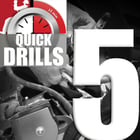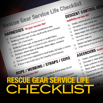 During a recent Roco Combat Technical Rescue course onboard the USS Alabama, an elite group of Pararescuemen were called to the “real thing” when a ship worker took a fall and needed to be rescued. According to Roco Tactical Chief Instructor Alex Reckendorf, the PJ’s performed a flawless rope rescue and integrated well with the Mobile Fire Department. He added, “As trainers, we are obviously very proud of their performance during this unexpected event. They represented both Pararescue and Roco well and are a credit to their career field.”
During a recent Roco Combat Technical Rescue course onboard the USS Alabama, an elite group of Pararescuemen were called to the “real thing” when a ship worker took a fall and needed to be rescued. According to Roco Tactical Chief Instructor Alex Reckendorf, the PJ’s performed a flawless rope rescue and integrated well with the Mobile Fire Department. He added, “As trainers, we are obviously very proud of their performance during this unexpected event. They represented both Pararescue and Roco well and are a credit to their career field.”
Eight local pararescue airmen from Hurlburt Field were in the middle of a training session aboard the USS Alabama on Tuesday when they found themselves in the right place at the right time.
On the second day of their confined space rescue training, the airmen from the 23rd Special Tactics Squadron were setting up for a rope rescue practice when a civilian painter, perched precariously on a ledge, fell 30 feet to one of the decks below.
The airmen jumped to action.
They gathered their gear, which included their medical equipment, and rushed to the scene of the accident.
The man landed on a deck about 50 feet above the main deck. He was experiencing severe back pain and feeling out of it from hitting his head.
 The airmen secured his back and gave him the medical attention he needed while coming up with a game plan for how to use their ropes to get him down to the main deck and then off the ship.
The airmen secured his back and gave him the medical attention he needed while coming up with a game plan for how to use their ropes to get him down to the main deck and then off the ship.
“It was pretty exciting for most of the guys to be able to utilize the training we had been working on all day and the day prior,” said Tech Sgt. Jason Humes, one of the pararescuemen who helped with the rescue. “It was all very fresh in our minds.”
Once the Mobile County firefighters arrived, the special tactics team explained their plan and worked together to secure the man in a rescue basket and use ropes to leap-frog him down from the deck and to the waiting ambulance.
Humes said an official from the USS Alabama reported to him on Wednesday that the man had broken a vertebrae, but they expected he would be back on his feet in several weeks and have a full recovery.
“All of us feel good we were able to help out and get him off as quick as we could so he’ll be up and running again in a few weeks,” Humes said.
Air Force Special Tactics pararescuemen are special operators whose primary mission is personnel recovery. They provide emergency and life-saving services for some of the more dangerous U.S. military missions, including deploying with Army Special Forces and Navy SEALs.
Air Force Lt. Jesse Galt, a special tactics officer who supervises several of the pararescumen involved in the rescue, was proud to see his airmen put their training to use in their real lives.
“It is a testament to their training and their poise that they are able to deploy those skills regardless of the situation,” he said. “It was cool to see.”
The article was written By LAUREN SAGE REINLIE | Daily News
Photo credit: U.S. AIR FORCE | Special to the Daily News


 In a recent article in ASSE’s Professional Safety magazine, we found some very important points to consider for rescuers. Whether you are preparing for stand-by rescue operations, getting ready to enter an “abandoned in place” vessel, or just found the “perfect” retired vessel to use for your upcoming rescue training…proceed with caution!
In a recent article in ASSE’s Professional Safety magazine, we found some very important points to consider for rescuers. Whether you are preparing for stand-by rescue operations, getting ready to enter an “abandoned in place” vessel, or just found the “perfect” retired vessel to use for your upcoming rescue training…proceed with caution! time to retire the equipment.
time to retire the equipment.  Being able to tie a knot in the classroom with a rope short vs. selecting the proper knot and tying it correctly in the field during an emergency requires experience. With a little imagination, you can provide your team members numerous scenarios to practice in just a short period of time while they are still within a controlled environment. This practice will help them to gain more experience that should pay off in the long run if needed during a real life emergency.
Being able to tie a knot in the classroom with a rope short vs. selecting the proper knot and tying it correctly in the field during an emergency requires experience. With a little imagination, you can provide your team members numerous scenarios to practice in just a short period of time while they are still within a controlled environment. This practice will help them to gain more experience that should pay off in the long run if needed during a real life emergency.
 On July 30 and 31, OSHA held an Emergency Response and Preparedness Stakeholders meeting in Washington, DC for the purpose of discussing the merits and potential content of an emergency response and preparedness standard.
On July 30 and 31, OSHA held an Emergency Response and Preparedness Stakeholders meeting in Washington, DC for the purpose of discussing the merits and potential content of an emergency response and preparedness standard. 
 Recently, we noticed a story in a leading safety and health magazine that questions the “two-piece, pass-through buckle” that is commonly used on many harnesses. The author, in fact, referred to it as a design flaw. However, we consider it more a matter of improper use than a design flaw. While he does identify some potential user failures, we feel his terming is not quite accurate. Here’s why...
Recently, we noticed a story in a leading safety and health magazine that questions the “two-piece, pass-through buckle” that is commonly used on many harnesses. The author, in fact, referred to it as a design flaw. However, we consider it more a matter of improper use than a design flaw. While he does identify some potential user failures, we feel his terming is not quite accurate. Here’s why... 



